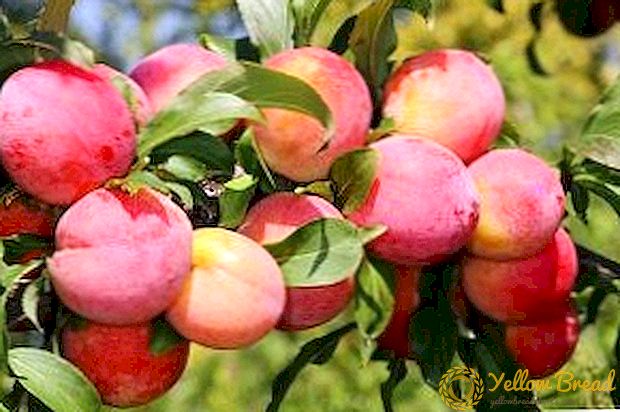 The second half of summer - it's time to replenish stocks for the winter. It is time to harvest, process and preserve vegetables.
The second half of summer - it's time to replenish stocks for the winter. It is time to harvest, process and preserve vegetables.
More delicate berries and fruits, except for cans, are sent to the freezer - for better preservation of vitamins.
But there is another type of blanks that many housewives practice, namely freezing of mushrooms collected or bought for the winter, and this process should be considered in more detail.
- What mushrooms are suitable
- Mushroom preparation
- Ways to freeze
- Raw mushrooms
- Boiled
- Stewed
- Fried
- How much can be stored
- How to defrost
What mushrooms are suitable
Fans of "quiet hunting" know that practically any edible species are suitable for such purposes. But best of all keep their taste:
- boletus mushrooms;
- chanterelles;
- honey agaric;
- boletus;
- aspen birds;
- Champignon.
 Slightly inferior to them, but still retain their gastronomic "notes", such as:
Slightly inferior to them, but still retain their gastronomic "notes", such as:- White mushrooms;
- oyster mushrooms;
- Wash;
- boletus;
- mushrooms;
- russula.
Most often used are purchased oyster mushrooms or champignons. This is the easiest option for citizens - not everyone has a forest nearby, and it is problematic to collect wild mushrooms without proper experience.
Forest harvesting is preferable (after all, "natural products"), but there are some nuances here. Only young plants taken from the edge of the massif should be assembled. Roadside is not suitable for food (due to its ability to absorb harmful substances through the mycelium). 
Mushroom preparation
Primary processing is done immediately after collection. Ideally, during the day. The most demanding in this regard are boletus, volvushki, honey agarics and aspen mushrooms. Having such a collection, you will have to act as quickly as possible.
Other species (especially oyster mushrooms) can withstand 1.5-2 days, although this should not be abused - useful substances and compounds "evaporate" quite briskly.
The rest of the preparation at home is quite simple, mushrooms, before they freeze, are subjected to such simple procedures:
- a thorough inspection - all old, cracked, limp or just suspicious instances set aside;
- from the remaining cleaned all the dirt and debris;
- then there is a thorough flushing with a change of water (with some of the useful properties lost, but safety is above all);
- after washing, they are laid out on a towel and dried.
 Already dry mushrooms are ready for further processing and freezing. The largest ones are neatly cut, while the smaller ones are trying to be left intact (although, for a smaller freezer, they will also have to be cut).
Already dry mushrooms are ready for further processing and freezing. The largest ones are neatly cut, while the smaller ones are trying to be left intact (although, for a smaller freezer, they will also have to be cut).Ways to freeze
Having already washed mushrooms, you can proceed directly to the freezing. Let's start with the easiest way to help save the newly collected material.
Raw mushrooms
The algorithm of such work will be as follows:
- Mushrooms are spread evenly over containers or a tray. The layer should be thin.
- Then the container is left in the freezer for 12 hours, "winding up" the maximum mode.
- After this time, the workpiece is removed, and the mushrooms themselves are distributed in ordinary plastic bags. They are put in the freezer, already working in standard mode.
 Many are interested in, and which mushrooms from the above list can be frozen, taken raw, and whether they really retain their nutritional qualities in such a simple way.
Many are interested in, and which mushrooms from the above list can be frozen, taken raw, and whether they really retain their nutritional qualities in such a simple way."High-speed" freezing without prior heat treatment Best suited for purely forest species, such as:
- chanterelles;
- boletus;
- boletus;
- aspen birds;
- honey agaric;
- champignons (collected on the edge of the forest, not purchased).
Boiled
It happens that the collected copies seem to be whole, but their condition does not hold out a bit to the "presentation". In such cases, helps out short brew:
- A large pot is placed on the middle fire. Calculate the volume is simple - 5 liters of water per 1 kg of collection.
- An already washed and cut billet is placed in the pan, which will be boiled for 5-10 minutes.
- Turning off the gas, you need to let the boiling water cool slightly and then remove all the pieces with a colander, decanting the water. Some mushrooms dry out, but this is optional.
- It remains to place the mushrooms in packages and put in the freezer.They are packaged in such a way that one sachet or container is enough to cook one dish - having opened the cellophane in winter, the product is immediately sent to cooking (melting, it very quickly loses vitamins and minerals, and the taste becomes not so saturated).
 The actual question remains, is it possible to freeze absolutely whole mushrooms, just by taking them raw and not boiling before being sent to the chamber.
The actual question remains, is it possible to freeze absolutely whole mushrooms, just by taking them raw and not boiling before being sent to the chamber.Practice suggests that nothing terrible will happen, but there is one culinary trick. If you freeze such products for cooking soup, then you can not scald, but for future frying, this procedure is required.
Stewed
This method allows preserve the flavor without much damage to the structure of the legs:
- The blanks are soaked in a solution of water with citric acid (1 tsp. To 1 liter). Stand 5-7 minutes.
- Then throw on a heated pan, pre-pouring there a little vegetable oil.
- Expose strong fire and stir for 4-5 minutes.To enhance the taste, you can add onions (crushed or rings). This "set" is fried for another 2-3 minutes.
- It remains to stew under the lid for 15-20 minutes, do not forget to slightly pepper and salt at the end.
- Turning off the gas, let the mushrooms brew a little under the lid.
The final chord - cooling and placement in containers or packages. It turned out a great base for pasta, which is sent to the freezer. 
Fried
Here, too, there is no particular difficulty:
- In the pan dripping 2 tablespoons of vegetable or olive oil.
- When it warms up on medium heat, it is necessary to lay out the cut collection in a thin layer.
- Duration zazharki may vary depending on the size - 4-5 minutes will be enough for small pieces, while larger ones can tighten up to 10-15.
- Then there is cooling (you can not cover the lid).
- Then everything is as usual: packing and the way to the fridge. The resulting product, lying there until winter, will be an excellent filling.
Often such processing is carried out not on the stove itself, but in the oven. So even more economically - oil is not required (it replaces its own juice). True, old plates can give uneven heating, and this moment should be kept in mind even before roasting.
How much can be stored
After all these works, a logical question arises: how much can you keep and store packaged and frozen mushrooms in a regular freezer?
Most often, the blanks are kept for no more than a year, maintaining a constant temperature in the chamber within -18 ... -19 ° С. But this is the most common figure, which can be adjusted depending on the method used in the freezing process. The condition of the refrigerator also plays its role.
If we add up all these factors, we get the following data:
- raw mushrooms will be the most useful from 8 to 10-11 months. By the annual "turn" they lose a little their taste;
- boiled and fried lie quietly for a year (if the packaging is not broken);
- The “useful maximum” of stews is 8 months, after which a gradual loss of nutritional properties begins.
As you can see, properly frozen mushrooms have a good shelf life - it will be something to decorate the New Year's table (and not only). 
How to defrost
The main rule is defrosting should be natural, without the participation of boiling water type boosters. You have to be patient: a two-kilogram package will not be defaced after 12 hours (or even more). Without such preparation, it is inconceivable to make soup or pasta from products that were boiled or stewed before long-term cooling.
But of all the rules are exceptions. So here - before you use frozen mushrooms for frying, a different housewife may not defrost them. In this case, it is not necessary: a heated pan very quickly “melts” the frost.But even before that you need to fry chopped onion on it, and only then put the workpiece itself.
Remember that it is undesirable to freeze the mushrooms again - the tasty collection at the same time turns into a shapeless and tasteless porridge. So calculate the necessary "dose" in advance to immediately use the valuable and tasty product from the pack completely. After defrosting, it is used without a long break.
In this article, you learned how to freeze freshly picked or just bought mushrooms. We hope these tips will help you decorate the winter table with unusual and tasty dishes. Do not be afraid to experiment!






